Puget Sound Energy (PSE), like all major utilities in Washington State, has long offered a Green Power program. This program allows you to enroll and pay an additional amount per kwh to get green energy. When we used to be PSE customers, we participated in the Green Power program in which we would pay a premium each month to make certain that what electricity we did buy from PSE (what we needed beyond what our solar pv produced), was sourced from clean energy sources. The main component in the Green Power program has been wind energy from a couple of large utility scale wind projects owned by PSE.
Now PSE is offering a solar specific green power program called Solar Choice. The Solar Choice program is similar to the existing Green Power program in that it offers customers the ability to pay a premium in order to make certain that PSE sources and allocates sufficient solar pv generated electricity to cover the amount you sign up to buy.
While this is very different from purchasing your own solar pv array for your own house, it is a good idea if you are a renter or have a shady roof and can’t install your own solar pv. The benefits are that you get the satisfaction of knowing there is some solar energy being produced somewhere with your name on those electrons, and you can participate or not as you choose. The more solar choices people have, the better.
If you own your house and have a sunny roof, its probably better to choose to make an upgrade to your house that will make clean power and decrease your home’s energy bills for decades.
https://pse.com/savingsandenergycenter/Renewables/Pages/default.aspx
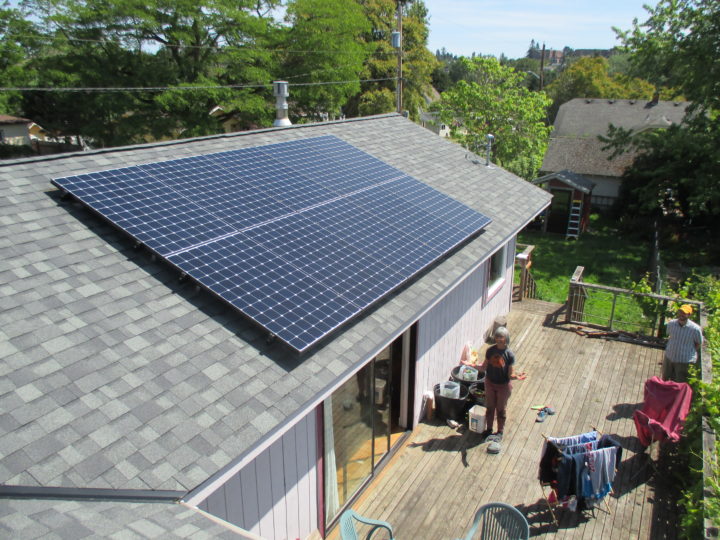
Palmer Residence, Dec 2016
by Andy Cochrane | May 15, 2017
The solar business is fun and dynamic. It feels great to be working in an industry which provides a long-term solutions for some of the problems inherent in the energy status quo, and because the majority of people consider themselves supporters of solar, we get a lot of interest and support even from people that are not our customers. While solar photovoltaic panels have been made continuously since the 1950’s using the basic same materials and techniques, the industry itself is more dynamic than the technology. Many business leaders (including us) see nothing but opportunity for growth, indeed every sunny rooftop I see is a place where I think solar pv should be installed. The barriers are not technological, they are economic and social barriers only.
We are a small company assessing the market to determine the best options for our clients. Based on our years of experience, we have become practical and skeptical of flashy marketing. This practicality often comes up when people inquire about new products, and lately it seems like Tesla is again the center of attention. An incredible company led by a charismatic genius CEO, they now have the largest market capitalization of any US car manufacturer, despite the fact that Tesla sold 80,000 cars in 2016, and Ford sold 6.7 million cars for example. Valuations are as much about stories as balance sheets, and Tesla’s leaders are master story tellers. They are also masters of shaping their own reality, as evidenced by the quality of the cars they manufacture dubbed “Car of the Century” by Car and Driver http://www.caranddriver.com/reviews/2015-tesla-model-s-70d-instrumented-test-review, and by the fact that they have installed the largest utility energy storage facilities in the world with their Li-ion batteries. http://blog.solarcity.com/island-in-the-sun/
Regarding the solar roofs, Tesla has announced they will begin taking orders in April, aiming to begin installations by the end of 2017. They are currently advertising for and hiring roofers, indicating initially at least they will begin as contractors with in-house installers, as Solar City (a national solar installer now owned by Tesla) has done. Of note, the company has a history of taking orders very early, and delaying delivery dates significantly. If you need a new roof now, or if you want to utilize the 30% federal tax credit currently in place, you probably shouldn’t wait for this product.
Eric Wesoff provides a survey of a couple of new solar roofs and several unsuccessful BIPV (Building Integrated solar PV, an industry term for solar roofs) ventures here: https://www.greentechmedia.com/articles/read/Tesla-Says-It-Will-Take-Orders-for-the-Solar-Roof-in-April
Will Tesla again succeed where others have failed? We are looking forward to seeing what they can accomplish, and how it will relate to the other options available at the time. In the meanwhile, we won’t be holding our breath.
Regardless of what the future may hold, what we have to offer right now is better than any time in the past, more watts per square foot at a lower price, with proven technology and 25 year warranties. We invite you to learn more at one of our upcoming events, we look forward to seeing you. https://powertripenergy.com/events/
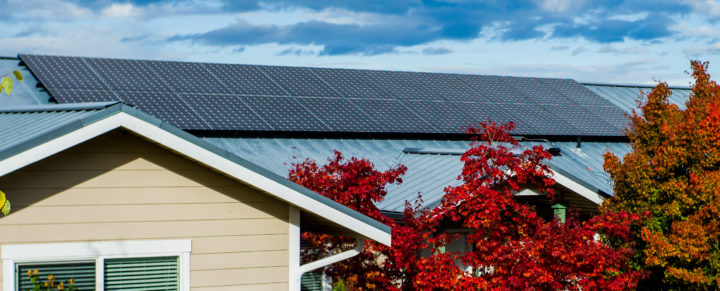
Meyer Residence, 7.6 KW (SunPower 345 watt modules) on the Clallam PUD grid in Sequim
by Andy Cochrane | Apr 11, 2017
Tesla was one of three companies that just brought online 70 Megawatts of instantly deployable lithium battery power, totaling approx 280 Megawatt-hours of energy storage. These projects were recently purchased by Southern California Edison (SCE) in response to the massive Aliso Canyon natural gas leak, which impacted gas supply for local plants, and the earlier than planned shut-down of the two San Onofre nuclear plants the company owns, due to premature wear which is still not understood.
This project represents the largest battery storage project in the world, and was completed faster than forecast, with a 100% safety record (no injuries during construction.) This 70 MW, represents the first step in a much larger eventual capacity for SCE. Some of the lithium battery storage they are deploying is on the customer side of the meter. This project is the main reason why you can’t get a Tesla Power Wall at the moment here on the Olympic Peninsula.
18 months ago, right after the initial Power Wall product announcement, I wrote that I hoped to see them within 12-18 months. 18 months later, I hope to see them in 12-18 months. Tesla is currently in “full production mode” at the Gigafactory outside Reno, NV, aiming to produce 50 Gigawatt-hours of battery capacity annually by next year, and eventually 150 Gwh annually. Gigafactory 2 has been announced for Europe, but no site has been determined yet. We can currently get products from other Lithium battery manufacturers that represent the first generation of this market, available for our clients who want to be on the cutting edge.
The synergy between utility scale solar pv and storage at the substation level is too sweet to ignore, and I expect to see continuing cost reductions and increase in the speed and efficiency of build-outs. In the meanwhile, if you have a sunny roof on your house, plain vanilla grid-tied pv is probably still your best option at the homeowner scale for the foreseeable future.
To learn more about the state of the art in Lithium battery deployment at the utility scale, Julia Pyper’s most recent article is a great place to start:
https://www.greentechmedia.com/articles/read/aliso-canyon-emergency-batteries-officially-up-and-running-from-tesla-green
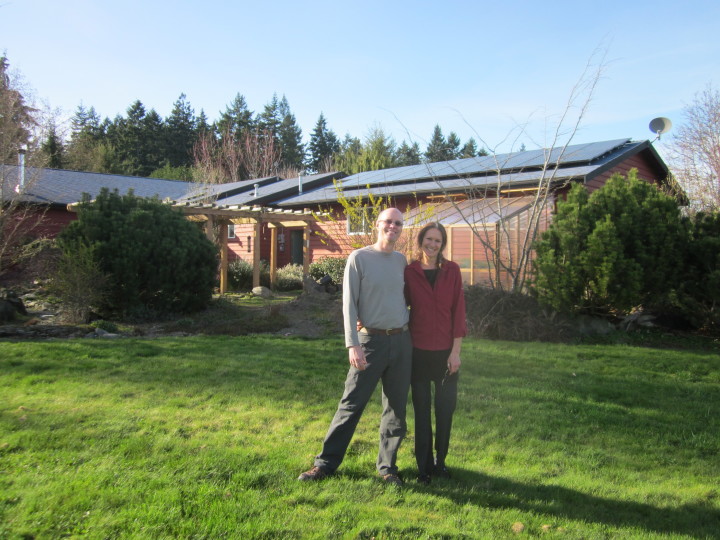
Chase-Tyler Residence
by Andy Cochrane | Feb 8, 2017
In November, Elon Musk spoke about Solar City’s plans to install solar roof tiles manufactured by Tesla. Many people have asked us about the potential of installing solar roof tiles. We look forward to seeing what becomes available and understanding the details of pricing and performance of this product. In the absence of any details from the manufacturer, you can look at pictures and sign up for updates here https://www.tesla.com/solar
This concept has previously been referred to by the nickname BIPV, denoting Building Integrated Photovoltaics, although we see that term used less these days. The concept of having one product that serves as roofing and also generates electricity is very attractive. It would be helpful to the product’s feasibility if the solar roof tiles cost less than the combination of a standard asphalt shingle roof with standard framed modules installed on top of it, but no solar roofing product that currently exists comes close to this price point. So in order to have a solar roofing product, customers will pay a premium. We have never installed one, though there have been many options available for over a decade, from Sharp Electronics, Open Energy, CertainTeed, and Dow, to name a few manufacturers. Musk claims that the Tesla solar roof tiles will cost less than a “dumb” roof. I look forward to seeing that, but I am not holding my breath while waiting.
The other solar roofing products on the market have a relatively low efficiency in terms of watts per square foot compared to standard mono-crystalline silicon modules. So even though there is the supposed convenience of a single product to install, the amount of energy that could be produced is actually lower than from a standard pv module array. In most residential installations, our design imperative is to produce as much energy as possible on the limited roof space available, so unless the Tesla product has a higher efficiency than the most efficient product currently available, it will involve making a sacrifice in performance. We are looking forward to the technical details to be able to make a true evaluation.
Only a portion of a home’s roof is practical for the installation of solar pv, eg, we would install solar on the south-facing roof, but not the north-facing roof of a simple house that is a single gabled rectangle. Most homes of course don’t have such simple roof shapes nor orientation. There are usually hips, dormers, clerestories and other roofs with different pitches and compass azimuths, and a big part of our design process is identifying and prioritizing the suitable roofs upon which to install pv. With the solar roof tiles, the question comes up as to what to do on the roofs not suitable for solar pv. Will Tesla provide a visually identical product minus the photovoltaic cells? I imagine this will be the intention, though this will surely raise the price further even for the roof planes not making energy.
Another aspect of this product that gives us pause is the need for a specialized tradesperson to perform the installation. In a solar installation on a standard home, the roof has been installed by roofing contractors who specify the products and warrant their roof installation for many years. The solar installers then install their product over the top of that and warrant our penetrations and product performance for many years. The roofers we work with are great, but it is a fair generalization to state that roofers are generally conservative and slow to adopt new products, which is exactly what you want in a roofer. As far as solar installers, they generally spend a lot of time surveying this rapidly changing market and keeping abreast of new products and dynamic pricing, updating their offerings for their clients as the options change and better products become feasible. There is an inherent tension in these two cultures, and the concept of combining those two trades into a single new trade is interesting. At Power Trip Energy, we have roofing skills related to penetrating, sealing, and flashing many different roof types in order to install our product on any roof, but we have no interest in becoming roofers at this time. In some situations with certain less common roofs or proprietary roofing membranes, we coordinate our installation with the roofers who follow us on the roof and come in right after us to flash our work and maintain responsibility for the entire roofs warranty. Perhaps other larger markets will lead in the creation of a new trade specialist, the solar electrician roofer, but we have yet to see evidence of that in the trade literature. If the installation will require coordination roofers and solar electricians, that coordination will inherently increase the cost of installation and inevitably slow us down.
There are unanswered design questions. Currently, if we are designing a system using string inverters that accept strings of DC electricity from the solar pv on the roof, we need to make certain we are bringing the DC power to the inverter with the proper voltage and amperage, sometimes a challenge to fully and exactly utilize available roof space. What will be the design constraints of these solar roof tiles? More often now instead of string inverters, we are using AC modules each with integrated micro-inverters in the 320 watt range, on a module that is roughly 15 square feet in area. If each solar roofing tile were to have its own integrated micro-inverter on a much smaller scale, that would increase costs and dramatically multiply the potential points of failure, and increase the complexity and expense of any warranty work. I doubt whether we will see solar roof tiles with integrated micro-inverters any time soon, but this is exactly where the leading edge of the market is right now for the standard framed modules.
Unless the solar roof tiles can provide some benefits that surprise me in relation to the issues I raised above, the only benefit is the aesthetics some people will find in the look of those roofs. We have been able to design systems to satisfy even the most aesthetic conscious clients using SunPower’s black-framed modules. Of course most of our clients find the creation of clean energy a thing of beauty in itself, and are happy to be reminded of their arrays when they come home.
Please pardon our slightly jaded response to some of the industry’s more hopeful forward-looking announcements, we have seen a lot of those in the last 14 years, and it is a rare jewel that makes it from announced intention to actually becoming the best product for your roof. We’ll be keeping a close eye on these developments and let you know when they are ready for you. In the meanwhile, what we have right now is a selection of the best solar products made to date, at the lowest prices ever seen, and a relatively friendly regulatory environment, facts which may combine to encourage you to act now rather than following Tesla’s implied advice to continue waiting for something better.
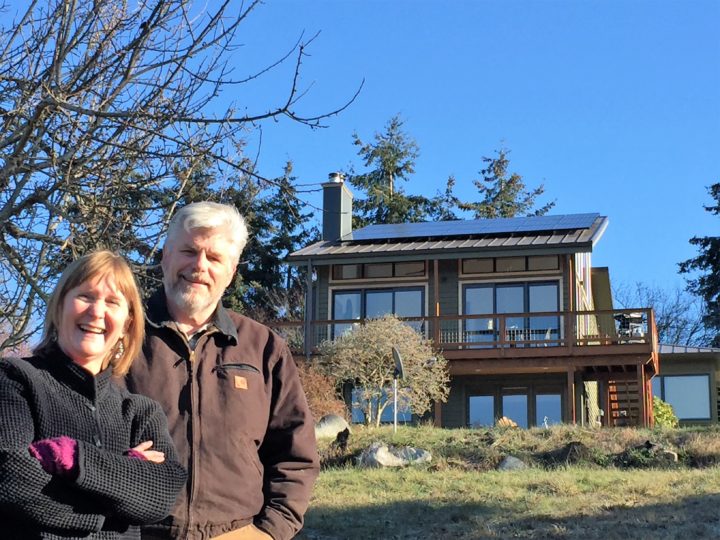
by Andy Cochrane | Jan 4, 2017
The incoming administration’s position on energy provides interesting insight into what is to be expected from the federal government in the next four years. The new administration will surely be friendlier to coal mining, oil drilling onshore and offshore, and fracking for natural gas.
https://greatagain.gov/energy-independence-69767de8166#.zce8a6e9p
If implemented, those strategies will degrade our natural environment, lease our public lands to their cronies at low rates, increase our transfer rate of carbon currently locked in the ground into the air as CO2, increase our contribution to climate change, and increase your dependence on the oil tyrants.
My personal response will be to enlarge the solar PV arrays at my home and business, and make certain as much of my driving as possible is in an electric vehicle.
In this way I can decrease my personal contribution to the negative aspects of the administration’s carbon-based fossil fuel plans, and minimize my financial support of the centralized energy corporations, while keeping more of my money available to invest in my own family’s future.
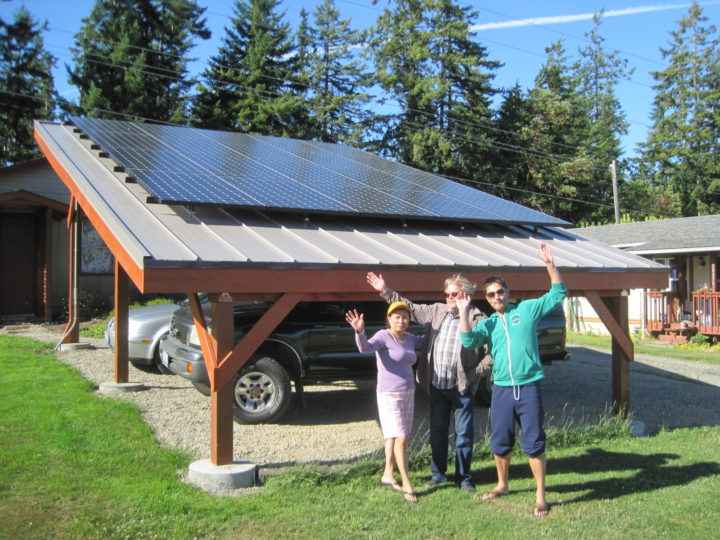
Morgan Residence, 6.9 KW SunPower, Port Angeles, June 2016
by Andy Cochrane | Dec 20, 2016
I recently read about two towns in California that have mandated the installation of grid-tied PV systems on newly constructed homes. This government legislation illustrates to me how far residential solar power has come. Just a couple of decades ago, solar power brought to mind one solar panel powering a flickering light bulb hanging from the ceiling of a wood cabin. And now City Councils are insisting upon solar! The passing of these laws leaves me wondering if legally mandating solar installations is a growing trend and what will this mean for the future?
The town of Sebastopol has about the same population as Port Townsend, Washington, around 8000 souls. In 2013, this quirky and decidedly liberal town passed a law requiring solar panels on all new buildings and additions with nearly unanimous support from its City Council. According to a May 10, 2013 article by Miranda Green of The Daily Beast, “Sebastopol’s ordinance orders that the solar systems must provide 2 watts of power per square foot or offset 75 percent of the structure’s electricity use.” So a humble 3.6 KW system would be required on an 1800 sq ft home.
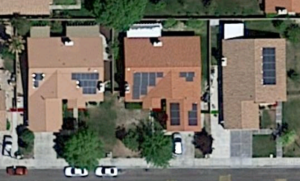
Lancaster, California was the first city in the United States to mandate solar panels on new construction. Photo: Map data ©2016 Google
Unlike Sebastopol, Lancaster, California is largely politically conservative. It has a population of around 150,000, about the same as the Washington State counties of Clallam, Jefferson, and Mason combined. According to Green, Lancaster was the first city in the United States to mandate solar panels on new construction. The city council was unanimous in approving a zoning code amendment requiring housing developers to add solar power systems on all new homes. This new code was initiated by the Republican mayor, R. Rex Parris, who wanted to make Lancaster the “solar capital of the universe.” The satellite photo of Lancaster above shows a segment of a housing development impacted by the legislation.
A Marketplace.org article posted on August 11, 2016, by Jed Kim addresses the question of mandating solar power. According to Kim, “Santa Monica recently approved an ordinance making rooftop solar systems mandatory for all new construction and major renovations.” San Francisco is planning on implementing similar legislation in 2017. Dean Kubani, Santa Monica’s chief sustainability officer, explained that the ordinance was approved to aid the city’s efforts to reduce emissions, “We, like a lot of other cities, are looking at greenhouse gas impacts and carbon impacts, and we’re trying to figure out how can we become carbon neutral.”
In the greentechmedia.com article, What It Really Means to Require Solar Panels on All New Buildings (June 20, 2016), Julian Spector writes, “Other municipalities have already reached out to San Francisco for more information about the policy, including Boston, Washington, D.C., Cambridge and Palo Alto.” Spector concludes, “The endgame will be cities where rooftop solar isn’t a personal challenge for a homeowner, it’s just one of many components expected of a market-ready property.”
It seems clear that mandating solar power is indeed a growing trend. However, I am hesitant to assert that solar power should be mandated for all new construction across the country. All too frequently, legislation that is meant to help people ends up presenting unintended consequences and sometimes does more harm than good. What are the possible unintended consequences of legislating solar installations? How successful are other incentive programs and commercial promotions in encouraging people to adopt solar power? If we wait for the market to come around to solar, will it happen fast enough to mitigate our climate crisis? What do you think? What questions do you have about this topic or other issues with solar power?
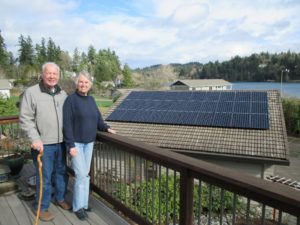
Proud new owners of a Power Trip Energy solar array, 2016
by Andy Cochrane | Sep 13, 2016
If you are like most environmentally conscious people, solar power has been on your radar for a very long time. You may have even developed a habit of waiting for the technology to become more solid, mainstream, and affordable; waiting for the first wave of users to help work out the kinks and develop a perfected product. Until about three weeks ago when I began my research on the Solar Agent position at Power Trip Energy, I thought we were still in waiting mode.
As my training on grid-tied PV has progressed at Power Trip Energy, it has dawned on me that the “early adopter” phase for residential solar power may have already passed. My family has always been the sort who are first on our block to embrace such things as microwave ovens and home computers, cell phones and Netflix. Thankfully, we can keep our technological early adopter self-image intact. Despite the fact that residential solar power has become so mainstream that we can now share our democratized power production with the utility grid and be paid for it at 100% the utility’s selling rate, we can still be the first on our block to invest in a flashy and affordable new solar array!
Your wait is truly over. Residential grid-tied PV solar technology has become more than a logical investment in the future livability of our planet; it has also become fiscally practical, paying for itself over time, increasing our property values, and significantly reducing our power bills immediately. Power Trip Energy was brave enough to show up early and paddle out to the big wave. Now they, I mean WE, are ready to join you in riding that wave back to shore.
What strikes me most about the super awesome community members at Power Trip Energy is their integrity and commitment to our habitat. From the electric personal cars and bicycles in our parking lot to partnering with companies that insist on producing solar modules sustainably, Power Trip Energy is making a real impact on our future for generations to come. I am honored to join them in this powerful movement and eager to share the electricity with you!

Photo taken on Puget Sound Express‘s Glacier Spirit whale watch touring vessel. Hudson Point Marina is in the background. Heather Flanagan is the newest member of the Power Trip Energy team. Originally from Portland, Oregon, she now calls Port Townsend her home. Heather lives in Uptown with her two boys, Logan and Blake.
by Andy Cochrane | Aug 26, 2016
Solar Agent
Join our team and be an agent of change, helping clients navigate their choices to determine whether and how to put grid-tied solar pv on their home.
You will have technical sales expertise, a driver’s license and clean driving record, and a desire to help our clients understand and make choices to harvest solar energy on their homes and businesses. You will be joining a small company and working alongside the owners. You will professionally represent us with integrity and excellent communications skills utilized for coordinating with the public, our clients, utilities and government regulators, and other departments within the company. You will be brutally honest, have excellent math and writing skills, be comfortable using a 32’ extension ladder to reach second story roofs. You will use company laptop, and vehicle. You will live in or around Port Townsend.
Specific tasks include:
- educating and qualifying customers over the phone and in person
- site analysis using ladder, hand tools, compass, camera, and cool high-tech shade analysis tools
- conceptual design and communication of financial cost, incentives, savings, and financing options during site visit
- detailed system design including performance estimates, requires good math skills including trigonometry and basic understanding of electricity and physics
- preparation of proposals, contracts using Word, Excel, SketchUp and solar design software
- answering questions in order to close the sales
- creating detailed project binders for the installation crew, including basic electrical calculations and one-line drawings
- creating basic permit applications using manufacturer’s engineered specs, shepherding applications through various jurisdictions
Additional marketing tasks may include graphic design of marketing materials, writing press releases, event coordination, and public speaking at indoor and outdoor events.
We provide a competitive compensation and benefits package including health insurance, paid sick and vacation time, paid and unpaid holidays throughout the year, quarterly bonuses based on profitability, 3% company IRA matching contribution, and continuing education funding.
Send resume and brief statement of your thoughts regarding renewable energy and grid-tied pv.
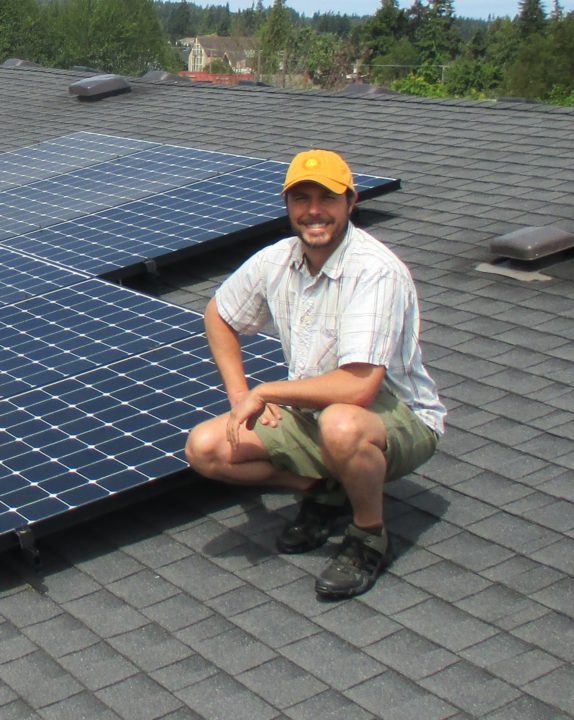
by Andy Cochrane | Jul 12, 2016
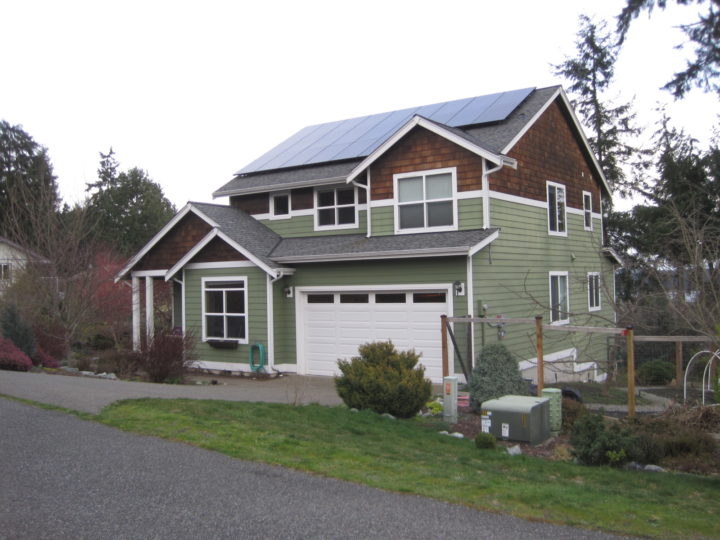
Mansfield Residence – 7.85 KW SunPower Array on Fronius 10 KW Inverter – Port Townsend – December 2015
SunPower last year verified 25.2% efficiency in a manufactured silicon-based PV cell. This year, they have integrated that cell into a manufactured PV module which attains 24.1% efficiency. When making efficiency comparisons, the cell-level efficiency is less relevant as in order for us to utilize that power, we need the cells built into a module, which will necessarily be slightly less efficient due to the space between cells, and the small area occupied by the frame.
When we are designing a system for a home’s roof, we usually need to make as much power as we can on the available roof space in order generate the largest percentage of the home’s annual energy. So using the most efficient modules available is important to us. While these SunPower modules are not the least expensive on the market, when we can put up an array with higher power rating in the same space as an average array, we can recognize relatively lower $/watt installation costs on all the other aspects of the system.
We are now commonly utilizing SunPower X-21 345 watt modules, which are 21.5% efficient at the module level. Their high efficiency, finish quality, and industry-leading warranty make SunPower an excellent choice for almost all of our clients. For example on the installation from last winter pictured above, we used the SunPower 327 watt modules to get 7.85 KW in the available un-shaded space. If we had used an average module, running ~290 watts in this size right now, that would be a 6.96 KW array in the same space, 12% less power installed for the same amount of work.
https://us.sunpower.com/blog/2016/06/26/sunpower-solar-module-verified-241-percent-efficient/
by Andy Cochrane | Jul 7, 2016
The annual Washington solar production incentive payments are based on the fiscal year from July 1 – June 30, so everybody with a grid-tied pv system is about to read their meters for the 2015/2016 year.
You will get a letter containing this form below. If you are a PSE customer, the form will be filled out for you. We are not certain what the Jefferson and Clallam PUD’s are planning this year. We have highlighted some of the important fields.
The main thing you want to bear in mind is to go read your production meter on June 30. Even if you are in PSE territory and they are going to read your meter and provide the information for you, we recommend reading your meter yourself at least annually. Then you will want to compare that figure with last year’s June 30 reading in order to get your annual production figure for this year. You will also be able to copy your DOR Tax Reporting Number from the top of last year’s form.
Unless you are among the minority of our clients who have the Made in Washington PV modules from Silicon Energy or Itek, you will use the field highlighted to report your total kilowatt-hours for the year. Although the base rate is stated as $0.15, all utilities in which we operate are or will be pro-rating this base rate due to the fact that the applications are now exceeding the available incentive pool, of 0.5% of taxable utility revenues.
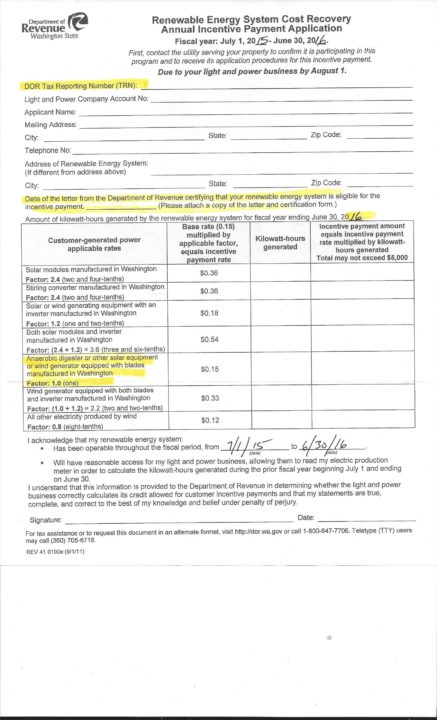
by Andy Cochrane | Jun 20, 2016










